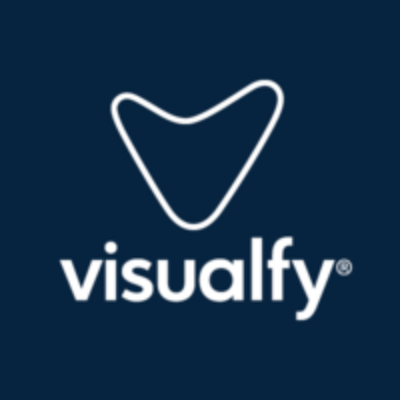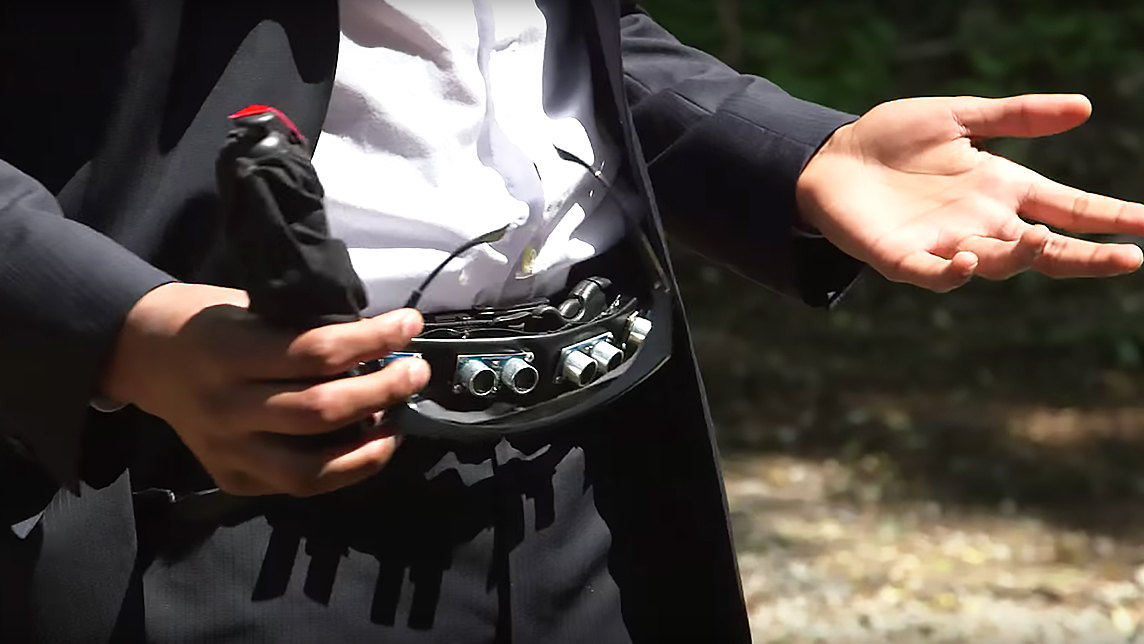Deafness is often called the invisible disability because it is unlike physical conditions that are easily spotted and their predicaments easily imagined, says Visualfy CEO and co-founder Manel Alcaide Dias. “The deaf's lack of visibility has [also] meant that tech products have not been made with them in mind,” he added.
Alcaide and Visualfy’s other co-founder, Angel Albiach Ruiz, should know. Both are fluent in Spanish sign language and have spent a combined 22 years working on improving communication and autonomy for the hearing impaired, although neither of them has hearing difficulties. But until Visualfy, there were no sensory tech solutions for the hearing-impaired, and people had to rely on expensive, tailor-made solutions.
Alcaide said: “Existing solutions were based on radio frequency. Just to be notified of a doorbell, you needed several pieces of equipment – you had to change the doorbell and you had to install different equipment inside and outside the house. Then the user had to carry a different device. So most people ended up looking for electricians to create home-made solutions.”
Visualfy was founded to truly address the needs of deaf people, and so is run by both deaf and non-deaf people "who care about designing the technological products the hearing-impaired have lacked until now," he told CompassList in an online interview early in February.
In three years, the Valencia-based startup has released two products, Visualfy Home and Visualfy Places, to cater to the day-to-day safety and autonomy needs of the deaf and provide them with visual representations to respond instantly to sound-based demands.
“When we started out, we saw that the existing market solutions were a bit obsolete, and also a bit expensive,” Alcaide said. In close consultation with hearing-impaired users, the co-founders got to work on developing a combined hardware and app employing AI-enhanced sound recognition for the deaf.
Visualfy raised €520,000 in seed funding in February 2021, bringing its total funding from private and public sources to over €5.5m since its launch in 2017. The startup will use the new financing to scale across Spain this year. It aims to raise more investment in 2022 to finance its international expansion, starting with Germany and France before it goes pan-EU, followed by the US and Japan, markets where the startup has already secured licenses.
Covid hampers accessibility
Visualfy Home was launched at 2018’s Mobile World Congress (MWC). It consists of a smart hardware device that interprets different sounds, plus sound detectors. Both are manufactured by industrial partner and investor INELCOM, one of Spain's biggest hardware developers. The interpreted sounds are then relayed via personalized colors and/or vibrating message notifications to Visualfy's iOS or Android app or another device of choice, such as Philips Hue lights.
Launched at 2019's MWC, Visualfy Places is a product that does the same for public buildings but which additionally features a universal color-coded notification system via smart lighting. In less than two years, Visualfy's Places has garnered important customers across Spain, including the Red Cross, the municipal authorities of Malaga and Valencia, and the governments of the autonomous regions of Madrid and Valencia.
The Covid-19 pandemic has been particularly stressful for the hearing impaired, Alcaide observed. They "now have to call everyone, including for all administrative tasks, instead of turning up in person,” he said. “As everyone has to wear a mask, it makes communication even more difficult for the hearing-impaired who could previously lip-read information.”
Masks make communication even more difficult for the hearing-impaired who lip-read information
Visualfy's response has been the imminent inclusion of an instant voice transcription service within its app. It’s adding a timer to the app and connected sensory devices, specifically to regularly remind users when to take medication via notifications. The startup says this was included in response to data showing that the deaf on average live five fewer years than those with hearing because of “a lack of access to health information.”
The details matter
Both Home and Places devices leverage AI within the hardware device connected to sound detectors that are required on each floor of a building, or in each room if the building is segmented. “What really concerned deaf people was knowing if someone were calling at the door, if the baby was crying, if the fire alarm had gone off – warnings that are concerned with their personal safety and personal autonomy, both at home and out and about,” Alcaide said.
Visualfy’s algorithm works to detect each common or important sound, identifying what it is and then sending a notification to the user’s smart device, be it a smartphone, smartwatch or smart wristband. “The adapted illumination is also activated via Wi-Fi. For example, it turns red in the case of an emergency alarm.”
The AI processing is somewhat unique in that, with European Union data privacy rules in mind, the information from the detectors cannot be processed in the cloud because of confidentiality. “The hardware actually processes the sound in situ, detecting and analyzing it with our algorithm, and, when it is identified, a push notification is sent to the device or whichever form of notification is required and the sound is eliminated with no-one else having access to it,” the CEO said.

In the case of Home, as each user's personal configuration is vital in order to cater to their particular sound environment, every sound that requires a reaction, such as a doorbell, has to be recorded for recognition by the algorithm. Home's app can incorporate any required sound – for example, the user's baby's cries or dog's bark – and the user app also identifies public spaces that have implemented Visualfy's technology.
In the case of Places, each building's sounds requiring a response are recorded prior to set up of the service. Notifications can be sent to any connected device chosen by users, including apps besides Visualfy's, such as WhatsApp and even hearing aids via their telecoil. Places also includes attractive smart lighting units.
While Home users can choose a different color pattern or vibration for each sound, for Places users there is a standardized code to follow, validated by the startup's deaf contributors. For example, red is the color pertaining to security. Other examples include yellow notifications and lights indicating the locking up of building or green for a change in staff rota.
In the case of large buildings implementing Places, Visualfy conducts an inspection. “If there is a five-story building with 1,000 workers and only an alarm in the hall, it's not feasible for deaf people,” Alcaide said. “In that case we put smart lights in the bathroom and work with interphones, locking doors, etc.” Each building hosting Visualfy Places displays explanations of the color-coded alert system situated in prominent locations.
Deafness on the increase
While the hearing-impaired may constitute a market niche, it is not an insignificant one by any economic measure. According to the World Health Organization (WHO), in Spain there are about 1m people experiencing hearing loss and 476m worldwide – a number that Visualfy says continues to grow.
“There are over 100m at risk of losing their hearing earlier due to earphone abuse. If we add pensioners who also suffer from hearing loss, there will be more than 900m affected by 2050 so the number is constantly increasing rather than decreasing in modern life,” Alcaide said. “Additionally, a study from the Disability Institute in Barcelona found that 97% of the city's buildings don't have any kind of acoustic accessibility and that's the same all over Europe.”
A study in Barcelona found that 97% of the city's buildings don't have any kind of acoustic accessibility
A recent EU directive increases the rights of the deaf to have accessible buildings and also increases business opportunities for Visualfy Places. Alcaide says that although most business owners are still unaware of the need to improve accessibility for the deaf, they are willing to implement changes.
“Headphone users in general, such as those working in call centers or in factories where staff need to wear ear protection are another potential market,” Alcaide added.
Visualfy obtained BCorp certification early on – an international measure of a company’s entire social and environmental performance. Last year, Visualfy also signed a commercial agreement with telco giant Telefónica in Spain for future collaboration.
Implementation costs subsidized
In 2017, Visualfy secured €2.55m in pre-seed funding towards product launch, including €1.2m from partner INELCOM and the Ship2B impact accelerator, and EU innovation funding of €1.35m under the Horizon2020 initiative. The February 2021 funding came from existing investors INELCOM and Ship2B, and new investors last-mile delivery company Smart Delivery Routes and the Canarian group Archipelago Next.
In terms of pricing, Visualfy Home has a one-off fee of €499 for the hardware and three sound detectors, plus an annual €24 fee for all functionalities. Visualfy Places’ pricing is dependent on the characteristics of each building, and its annual upkeep fee also varies according to the number of buildings where the system is implemented.
Alcaide pointed out that autonomous regions in Spain help to subsidize implementation of the technology. For example, the government of the Valencian region pays back 60–90% of the cost of the hardware for Home, according to the level of hearing loss experienced. EU funds are also available for both public and private buildings to become accessible to deaf people.

Visualfy has also benefitted from winning high-profile prizes. In both 2018 and 2019, the startup won BCorp’s social impact startup prize Best for the World in the Customers’ category. In 2020, it clinched the United Nations World Tourism Organization (UNWTO) Smart Destinations award.
As a concept, Visualfy originated from a social media project in 2014 under the co-founders’ previous startup, Fusió d'Arts Technology, a Valencia-based communications agency for the disabled.
When the pair received positive feedback from hearing-impaired people in 122 nations on their proposed project on accessibility issues for the Valencian Association of Deaf People, the co-founders decided to pivot from their agency to founding Visualfy as a separate tech startup. Childhood friends Alcaide and Albiach also participated in the US accelerator StartupsMansion at the outset in 2014, applied for initial EU innovation funding the same year and boosted their own tech skills which, especially in Alcaide's case, were quite basic then.
Alcaide recalled how, in the absence of a sound recognition algorithm, the pair got to work with peers constructing their own: “We didn't yet have the algorithm, but we had lots of friends. So we persuaded them to put in eight-hour stints with headphones on, listening to the sounds in houses of deaf people to see which noises were most important for them to recognize, and the range of those possible sounds.”














